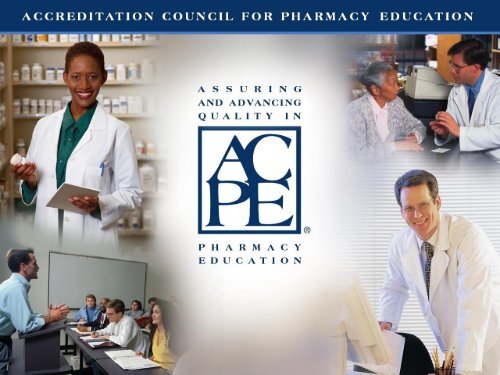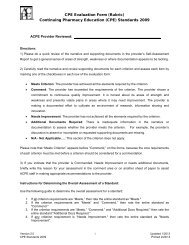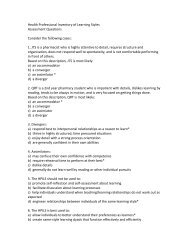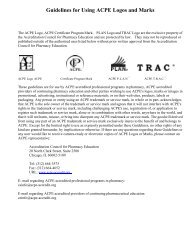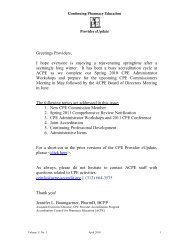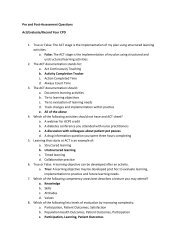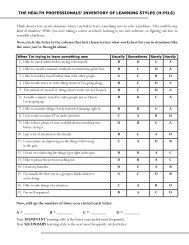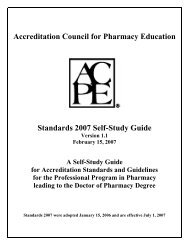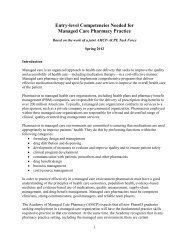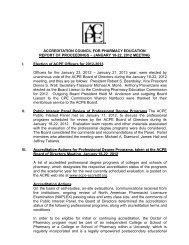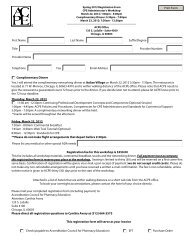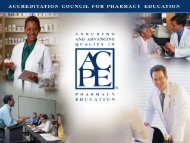ACPE Communications - Accreditation Council for Pharmacy ...
ACPE Communications - Accreditation Council for Pharmacy ...
ACPE Communications - Accreditation Council for Pharmacy ...
Create successful ePaper yourself
Turn your PDF publications into a flip-book with our unique Google optimized e-Paper software.
This session’s voucher code:9M9L-J73C
Disclosure• Dr. Vlasses has no commercial interests todeclare.
<strong>ACPE</strong> History• Founded in 1932 <strong>for</strong> accreditation ofprofessional degree programs by:– National Association of Boards of <strong>Pharmacy</strong>(NABP) (regulators)– American Association of Colleges of <strong>Pharmacy</strong>(AACP) (educators)– American Pharmacists Association (APhA)(practitioners)
<strong>ACPE</strong> History• <strong>ACPE</strong> is an autonomous, independent, not<strong>for</strong>-profitagency• <strong>Accreditation</strong> of CE Providers added in 1975• <strong>Accreditation</strong> of Certificate Programs(1999 – 2008)• International Services Program added in 2011• New HQ address: 135 S. LaSalle St., Suite4100, Chicago, IL 60603
<strong>ACPE</strong> Board of Directors• Heidi M. Anderson, PhD(AACP, 2006–2012)• Robert Beardsley, RPh, PhD(AACP, 2008–2014) -President• Michael A. Moné, RPh, JD(NABP, 2006–2012)Secretary/Treasurer• Barbara G. Burch, MS, EdD(ACE, 2010–2016)• Bruce Canaday, PharmD(APhA, 2010–2016)• Stephanie F. Gardner, PharmD, EdD(AACP, 2010–2016)• Dennis K. McAllister, RPh(NABP, 2010–2016)• Warren A. Narducci, PharmD(APhA, 2006–2012)• Anthony Provenzano, PharmD(APhA, 2011–2014)• Donna S. Wall, PharmD(NABP, 2008–2014)Vice President
<strong>ACPE</strong> Board of Directors –New Appointees• Michael A. Moné, RPh, JD(reappointed by NABP, 2012–2018)• Victoria F. Roche, PhD(appointed by AACP, 2012–2018)• Timothy L. Tucker, PharmD(appointed by APhA, 2012–2018)
Learning Objectives• Discuss the quantitative nature of the expansion ofpharmacy degree programs and pharmacygraduates in the U.S. over the past decade• Describe the standards and procedures that <strong>ACPE</strong>uses to evaluate the quality of new colleges andschools of pharmacy• List several objective and subjective markers that<strong>ACPE</strong> uses to evaluate the quality of pharmacydegree programs• Discuss why <strong>ACPE</strong> has no role in limiting thenumber of colleges and schools of pharmacy or thenumber of pharmacy graduates
EXPANSION OF PROFESSIONALDEGREE PROGRAMS
Which ONE of the following is True?a) The number of pharmacy colleges/schools withan <strong>ACPE</strong> status has doubled since 2000b) The number of pharmacy graduates in 2014 isprojected to be about double the number in 1990c) In 2011, about half of colleges and schools ofpharmacy with full accreditation have branchcampusesd) None of the above
Accredited PharmD Programs*Programs with accreditation status (n = 127):• Full <strong>Accreditation</strong> Status: 102(programs that have graduated students)• Candidate <strong>Accreditation</strong> Status: 17(programs with students enrolled but have not yet produced graduatesor have graduates and have not addressed all the accreditationstandards)• Pre-Candidate <strong>Accreditation</strong> Status: 8(programs that have not yet enrolled students or are in their first year ofclasses)* Inclusive of January 2012 Board Actions
197019751980198519901995200020022004200520062007200820092010201120121401201008060Colleges and Schools of <strong>Pharmacy</strong>with <strong>ACPE</strong>-Accredited DegreePrograms*4020Schools With No DegreesConferred0* Inclusive of January 2012 Board Actions
Distance Campus Expansions• 26 programs have distance campuses*– 19 are public and 7 are private• 3 programs are in the process of beingevaluated to open a distance campus• 5 programs have branch/distance campusesout of state(* Distance campus = delivery of didactic curriculum to/from site)
Number of Graduates<strong>Pharmacy</strong> school graduates 2011–2014projected based on current enrollmentand <strong>ACPE</strong>-estimated attrition<strong>Pharmacy</strong> School Graduation Trends1400013,8221200011,4871000080006,9566000400020000Source: AACP Fall 2010 Data and <strong>ACPE</strong> February 2011 Estimates
True or False?The majority of the increase in U.S.pharmacy graduates between 2003 and2010 is due to expansion of enrollmentsby accredited colleges and schools ofpharmacy that existed prior to 1995.
Increase in No. of Graduates(from 2003 baseline)Increase in <strong>Pharmacy</strong> Graduates Since 2003Source: AACP Fall 2010 Data and <strong>ACPE</strong> February 2011 Estimates7000600050004000Increase attributable to pre-1995 schoolsIncrease attributable to post-1995 schoolsn = 98n = total number of US colleges andn = 93schools with graduatesn = 90n = 102n = 110n = 114n = 1183000n = 88n = 8920001000n = 83n = 8502004 2005 2006 2007 2008 2009 2010 2011 2012 2013 2014(Actual numbers)(Projected numbers)
Increase in No. of Graduates(from 2003 baseline)Increase in <strong>Pharmacy</strong> Graduates Since 2003Source: AACP Fall 2010 Data and <strong>ACPE</strong> February 2011 Estimates7000600050004000Increase attributable to pre-1995 schoolsIncrease attributable to post-1995 schoolsn = 98n = total number of US colleges andn = 93schools with graduatesn = 90n = 102n = 110n = 114n = 1183000n = 88n = 8920001000n = 83n = 8502004 2005 2006 2007 2008 2009 2010 2011 2012 2013 2014(Actual numbers)(Projected numbers)
True or False?In the last decade of the health professiondegree programs (e.g., medicine,osteopathic medicine, nursing), only theprofession of pharmacy is seeing an increasein the number of colleges and school seekingaccreditation.
Growth Trends in EducationAmong Other Health ProfessionsHealth Profession/AccreditorAccredited Programs2000Accredited ProgramsPlus Applications(Net % Change)2011Medicine (LCME) 125 141 (+13%)Osteopathy (AOA-COCC) 19 28 (+47%)Nursing (CCNE) DNP = 0 (new degree) 58Physical Therapy (APTA) 196 229 (+17%)Occupational Therapy(OTA) 131 154 (+18%)Dentistry (ADA CODA) 55 60 (+9%)
STANDARDS AND PROCEDURESUSED TO EVALUATE NEW DEGREE PROGRAMAPPLICANTS
<strong>ACPE</strong> StandardsUSDE CriteriaStandardizationConsistencyProgram-driven; <strong>ACPE</strong>-encouragedInnovationIndividuality
Joint Commission of <strong>Pharmacy</strong>Practitioners (JCPP) Vision<strong>Pharmacy</strong> education and continuing education willprepare pharmacists to:• Provide patient-centered and population-based carethat optimizes medication therapy• Manage health care system resources to improvetherapeutic outcomes• Promote health improvement, wellness, and diseasepreventionJCPP Vision <strong>for</strong>ms basis of <strong>ACPE</strong> standards <strong>for</strong>degree programs and CPE providers
Standards 2007 Guidelines v2.0• Mission, Planning, and Evaluation• Organization and Administration• Curriculum• Expected student competencies• Assessment of student learning• Mapping to Appendix B required• Students• Faculty and Staff• Facilities and Resources30Standards*151GuidelinesAppendix B =Guidance on the science foundation of curriculum
The PharmD DegreeKNOW DO BEKnowledge + + + + + + + + Skills + + + + + + + Attitudes/BehaviorPre-ProfessionalBehavioral, Social, Admin& Clinical Sciences/Apply & build onknowledgeBiomedical &PharmaceuticalSciences/DidacticIPPEs and simulations<strong>Pharmacy</strong> PracticeExperiences APPEs(patient settings)ENTER PRACTICE2 years (min.) 3 years 1 yearDependent/directed learnerIndependent/self-directedlifelong learner
New School ProcessRequired Evaluations & On-site Visits <strong>for</strong><strong>ACPE</strong> <strong>Accreditation</strong> of New ProgramsDraft Application On-site Consultation (1 staff member)Paper review of draft application (team of 4)Evaluation <strong>for</strong> Precandidate Status (team of 4-5)Evaluation <strong>for</strong> Candidate Status (team of 4-5)Evaluation <strong>for</strong> Continuation ofCandidate Status (team of 2-3)Over 7 years: a New Program is evaluated by 24–36 individualsConsideration of Full Status (team of 4-5)Evaluation <strong>for</strong> Continuation of Initial Full Status(team of 2-3)
Precandidate Thresholds• Programs must meet threshold expectations<strong>for</strong> 20 distinct elements to qualify <strong>for</strong> aninitial comprehensive on-site evaluation• Detailed overview of threshold elementswww.acpe-accredit.org/pdf/Threshold_Document.pdf
Precandidate Thresholds• Mission includes scholarship• University infrastructuresupports research andscholarship• Institution is regionallyaccredited• Institution is authorized togrant a doctoral degree• Dean is installed withsufficient time to develop theprogram• Dean is qualified and hasauthority as defined bystandard 8• Dean has appropriate priorexperience• Dean has appropriateresearch and scholarshipbackground.• Full-time faculty leadershipteam installed• Leadership team hasessential skills complementingthose of the Dean
Precandidate Thresholds• First-year Faculty in Place byFirst Team Visit• Senior Faculty ProvideMentoring• Curriculum and Draft SyllabiHave Been Prepared• Curricular Map ShowsSufficient Hours• Student Services Availableby First Day of Classes• Physical Facilities Availableon Proposed First Day ofClasses• Funding Matches ProgramActivity• IPPEs Will Be Ready WhenNeeded• APPEs Will Be Ready WhenNeeded• No Significant ProgramExpansion
True or False?50% of the new programs that appliedto <strong>ACPE</strong> from 2008 to 2011 were notauthorized <strong>for</strong> an on-site visit on theirinitial application attempt.
Precandidate Thresholds• Some programs authorized <strong>for</strong> a site visit arenot subsequently approved <strong>for</strong> precandidatestatus– Recently 3 programs denied/withdrew– Accepted students unable to proceed– Costly and challenging <strong>for</strong> everyone
EVALUATING THE QUALITY OF PHARMACYDEGREE PROGRAMS
<strong>ACPE</strong> Monitoring of <strong>Pharmacy</strong>Programs – Quality and Resources• Comprehensive and focused accreditation reviews• Annual monitoring metrics (e.g., NAPLEX,enrollments, progression/graduation, dismissals,withdrawals, attrition)• AACP standardized surveys (e.g., graduatingstudents, faculty, preceptors, and alumni)• Launch of Assessment and <strong>Accreditation</strong>Management System (AAMS) with AACP• Identification of noteworthy practices
True or False?Graduates of colleges and schools ofpharmacy that have opened and beenaccredited since 1995 have lower averageNAPLEX first time pass rates thangraduates of accredited colleges andschools that had graduates prior to 1995.
Passing RateNAPLEX Passing Rate <strong>for</strong> First-TimeCandidates 2004–2010Pre-1995 versus Post-1995 Programs100%98%96%94%92%90%88%86%84%82%80%96.7%95.8%7 Post-1995Programs92.0%85.9%93.0%92.3%95.6%97.0%96.7%95.1% 96.3% 96.5%94.4%94.1%2004 2005 2006 2007 2008 2009 201024 Post-1995ProgramsPre-1995ProgramsPost-1995Programs
Percentage of Programsn = 1n = 3n = 1n = 2n = 6n = 1n= 23n = 12n= 39n = 1060%2010 NAPLEX Passing Rate Spread <strong>for</strong>Pre-1995 versus Post-1995 Programs50%40%30%20%Pre-1995ProgramsPost-1995Programs10%0%66 -70% 71 - 75% 76 - 80% 81 - 85% 86 - 90% 91 - 95% 96 -100%
True or False?To date, graduates of accredited pharmacydegree programs with 3 calendar yearcurricula have an average first timeNAPLEX passing rate that is comparableto graduates of programs with 4 academicyear curricula.
n = 7n = 83n = 8n = 85n = 8n = 90NAPLEX Passing Rate <strong>for</strong> First-TimeCandidates 2008 – 2010Three-Year vs. Four-Year Programs99%94%96.9%95.7% 96.2%96.7%93.9%94.4%89%84%79%74%Three-YearProgramsFour-YearPrograms69%2008 2009 2010
2010 Graduating Student Survey ResultsSection I: Professional Competencies/Outcomes (N = 7,496)The PharmD Program prepared me to:The PharmD Program prepared me to:Communicate with Communicate patients with patients and caregiversand 54.5%43.5%1.7%Gather and use specific in<strong>for</strong>mation toGather identify and use patient specific in<strong>for</strong>mation medication-relatedto identify patientmedication-related problemsproblemsDevelop a patient care plan to manageeach medication-related problemDevelop a patient care plan to manage each medication-relatedproblem54.4%50.0%43.7%47.9%1.6%1.9%StronglyAgreeAgreeWork with a health care team to implementWork with a health care team to implement the patient the patient care planManage the system of medication use toManage the system of medication useaffectto affectpatients43.4%37.4%51.5%55.7%4.6%4.4%Disagree/StronglyDisagreeWork with other stakeholders and resolveproblems related to medication useWork with other stakeholders to identify and resolve problemsrelated to medication use41.3%55.0%3.2%
My introductory pharmacy practiceexperiences were valuable in helping toprepare me <strong>for</strong> my advanced pharmacypractice experiences2010 Graduating Student Survey ResultsSection III: <strong>Pharmacy</strong> Practice Experiences (N = 7,496)24.1%48.5%21.4%My introductory pharmacy practice experiencespermitted my involvement in direct patient careresponsibilities in both community andinstitutional settingsIn the community pharmacy setting, I wasable to apply my patient care skills23.4%42.3%47.5%47.8%22.9%8.7%StronglyAgreeIn the ambulatory care setting, I was able toapply my patient care skills54.0%39.6%4.1%AgreeIn the hospital or health-system pharmacysetting, I was able to apply my patient careskillsIn the inpatient/acute care setting, I was ableto apply my patient care skills43.4%48.5%47.2%45.2%8.3%4.4%Disagree/StronglyDisagreeOverall, my advanced practice experienceswere valuable in helping me to achieve theprofessional competencies46.9%48.3%4.0%
2010 Faculty and Preceptor Survey Curriculum Responses(Faculty N = 2,604 / Preceptor N = 8,170)The PharmD Program preparedstudents to:Develop and use patient-specific careplans96.3%97.5%Efficiently manage a patient-centeredpharmacy practiceDevelop disease managementprogramsManage the system of medication usePromote the availability of healthpromotion and disease preventioninitiativesCommunicate with patients, caregivers,and other members of theinterprofessional health care team93.9%93.6%91.1%89.9%94.5%93.7%95.4%94.4%96.8%97.2%PreceptorStronglyAgree/AgreeFacultyStronglyAgree/Agree
The Pharm.D. PharmD Program Program prepared prepared students to:students to:2010 Faculty and Preceptor Survey Curriculum Responses(Faculty N = 2,604 / Preceptor N = 8,170)Search the health sciences literatureSearch the health sciencesliteratureSearch the health sciences literatureEvaluate the health sciencesEvaluate the health sciences literatureliteratureEvaluate the health sciences literatureDemonstrate expertise in the areaDemonstrate expertise in the of area in<strong>for</strong>maticsof Demonstrate expertise in the area ofin<strong>for</strong>maticsApply state and federal laws andApply state and federal laws andregulations to the practice ofpharmacyApply state and federal laws and regulations to the practice ofregulations to the pharmacy practice of pharmacy82.9%90.6%94.1%94.2%92.0%96.7%96.6%98.2%PreceptorStronglyAgree/AgreeFacultyStronglyAgree/AgreeMaintain professional competenceMaintain professional competenceMaintain professional competence97.9%96.1%
AAMS is a joint project of AACP and <strong>ACPE</strong>
Question 86: If I were starting my college career over againI would choose to study pharmacy.
Program vs. National Average Comparison
<strong>ACPE</strong> Stakeholder ConferenceSeptember 12–14, 2012Atlanta, GA• Advancing Quality in <strong>Pharmacy</strong> Education:Charting <strong>Accreditation</strong>’s Future• Invitational consensus-seeking conference– Including APhA-ASP• In collaboration with a broad array ofleaders in pharmacy, health care, andeducation
<strong>ACPE</strong> Stakeholder ConferenceObjectives• Examine competencies that are currentlyrequired of pharmacists and competenciesthat will be required in the future• Expand evidence-based practices inassessing the quality of educationalprograms• In<strong>for</strong>m standards, guidelines, and processquality improvement initiatives
True or False?<strong>ACPE</strong> can intervene to stop the rapidexpansion of pharmacy schools in the U.S.,especially those in the state of Cali<strong>for</strong>nia.
Manpower Issues Cannot BeConsidered in <strong>Accreditation</strong>• <strong>Accreditation</strong> is designed to advancequality – not restrict the market• Sherman Antitrust Act of 1890 prohibitsrestraint of competition• PharmD is a nationally recruited applicantpool with national employmentopportunities
<strong>Accreditation</strong> and Competition• <strong>Accreditation</strong> decisions may affect themarketplace• <strong>Accreditation</strong> decisions are based strictly oncompliance with the standards– Cannot consider the effect on the marketplace• Consideration of the effect on the marketplacein making accreditation decisions could subject<strong>ACPE</strong> to prosecution under antitrust laws and,potentially, jeopardize <strong>ACPE</strong>’s recognition bythe U.S. DOE
Which ONE of the following is True?According to AACP’s PharmCAS centralized pharmacyprogram application system, the number of Cali<strong>for</strong>niaresidents that matriculated as first year students inprograms outside the state in 2011 is:a) 12b) 189c) 332d) 582e) 1,024
www.acpe-accredit.org


